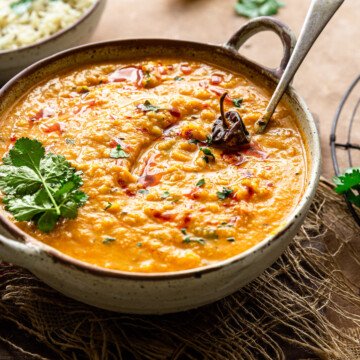
Dhaba Dal
Dhaba Dal is a hearty and flavorful Indian dish made with a mix of lentils, typically cooked with spices, tomatoes, and onions. It’s known for its rich, smoky flavor, often enhanced by cooking over an open flame. Commonly served with rice or naan, it captures the essence of rustic roadside eateries (dhabas) in India.
Ingredients
Ingredients
For the Dal:
- ½ Cup Toor dal (pigeon peas)
- ½ Cup Chana dal (split chickpeas)
- ¼ Cup Moong dal (green gram)
- 1 Medium onion, finely chopped
- 2 Medium tomatoes, finely chopped
- 1 tablespoon Ginger-garlic paste
- 1 teaspoon Turmeric powder
- 1 teaspoon Red chili powder
- 1 teaspoon Cumin seeds
- 1 teaspoon Coriander powder
- 1 teaspoon Garam masala
- 2 tablespoon Ghee or oil
- Salt to taste
- 4 Cups Water
For the Tadka (Tempering):
- 2 tablespoon Ghee or oil
- 1 teaspoon Cumin seeds
- 1 teaspoon Mustard seeds (optional)
- 2-3 Dried red chilies
- ½ teaspoon Hing (asafoetida, optional)
- 4-5 Cloves of garlic, thinly sliced
- 1 tablespoon Ginger, finely chopped
- 1 Green chili, slit
- 1 tablespoon Chopped fresh coriander leaves (for garnish)
Instructions
Prep the Lentils
- First, wash your dal (lentils) thoroughly to remove any impurities. Then, soak them for 20-30 minutes to soften them, making the cooking process quicker. This step will help achieve that perfect texture!
Cook the Dal
- Next, add the soaked lentils to water, along with turmeric and salt. Cook them until soft, either in a pressure cooker, stovetop, or Instant Pot — whichever method you prefer! Don’t forget to adjust the water for your desired consistency!
3Make the Tadka (Tempering)
- Meanwhile, heat ghee (or oil) in a pan. Then, add cumin seeds, mustard seeds, dry red chilies, and a pinch of asafoetida. Let it sizzle and pop to release all those wonderful flavors!
Add Onions, Tomatoes & Spices
- Now, sauté onions, garlic, and ginger in the pan until golden. Afterward, toss in chopped tomatoes, red chili powder, coriander powder, and garam masala. Stir it all together to create a rich, aromatic base.
5Combine the Tadka & Dal
- Once the dal is cooked, pour the flavorful tadka over it. Give it a good stir, then let it simmer for a few minutes to allow the spices and dal to meld together beautifully. The magic is happening!
Garnish & Serve
- Finally, garnish with fresh cilantro and a squeeze of lemon juice for a burst of freshness. You can even drizzle some extra ghee for richness. Serve your delicious Dhaba Dal with hot, fluffy rice or naan for the ultimate comfort meal!
Notes
Variations
Different Lentils, Different FlavorsFirst, why not mix up your lentils? For a creamy, hearty texture, combine toor dal and masoor dal. Alternatively, if you're craving something lighter, go for moong dal for a fresher, milder taste. Either way, each combination gives the dal a unique flavor and vibe! Spicy Dhaba Dal
If you're a spice lover, crank up the heat! Add extra green chilies, red chili powder, or even a bit of green chili paste to give the dal a fiery kick. You’ll be feeling the burn, but in the best way possible! Smoky Dhaba Dal (Dum)
For a smoky twist, you can try the "dhungar" method! First, place a piece of burning charcoal in the cooked dal. Then, cover it and let the smoky aroma slowly infuse the dish. This simple step will bring the authentic dhaba flavors straight to your kitchen, creating that irresistible smoky richness! Veggie-Packed Dal
Want to make your dal more hearty and nutritious? Add some veggies like spinach (palak), carrots, or bottle gourd (lauki). These not only add texture but also make the dish more colorful and full of goodness! Creamy Dhaba Dal
Finally, for a rich, luxurious finish, stir in some cream or a dollop of butter. This gives the dal a smooth, creamy texture—just like the kind you'd find at an upscale dhaba! It’s comfort food at its finest.
Pro-Tips
1. Cooking the Dal to the Right ConsistencyFirst, cook the dal until it’s soft and creamy, but still holds its shape. It shouldn’t be too thick or too watery — aim for a nice, smooth texture! 2. Balancing the Spices
Next, adjust the spices based on your taste. If it’s too spicy, you can always add a spoon of yogurt or cream to calm it down and make it just right. 3. The Importance of Tadka
Don’t forget the tadka! Heat the oil or ghee properly before adding spices, as this helps release their full flavors and gives the dal that signature aroma. 4. Using Fresh Ingredients
For the best taste, always use fresh ginger, garlic, and tomatoes. Fresh cilantro on top adds a refreshing touch that balances out the rich flavors. 5. Simmering the Dal for Flavor
Finally, let the dal simmer for a few extra minutes after adding the tadka. This helps the spices fully blend into the dal for richer flavor.
Nutrition
Nutrition Facts
Dhaba Dal
Amount per Serving
Calories
1200
% Daily Value*
Fat
48
g
74
%
Saturated Fat
20
g
125
%
Polyunsaturated Fat
4
g
Monounsaturated Fat
24
g
Cholesterol
60
mg
20
%
Sodium
800
mg
35
%
Potassium
1800
mg
51
%
Carbohydrates
180
g
60
%
Fiber
30
g
125
%
Sugar
12
g
13
%
Protein
54
g
108
%
Vitamin A
1200
IU
24
%
Vitamin B1
0.5
mg
33
%
Vitamin B2
0.3
mg
18
%
Vitamin B3
5
mg
25
%
Vitamin B5
1
mg
10
%
Vitamin B6
0.6
mg
30
%
Vitamin C
35
mg
42
%
Vitamin E
3
mg
20
%
Vitamin K
10
µg
10
%
Calcium
120
mg
12
%
Iron
8
mg
44
%
* Percent Daily Values are based on a 2000 calorie diet.
Tried this recipe?Let us know how it was!